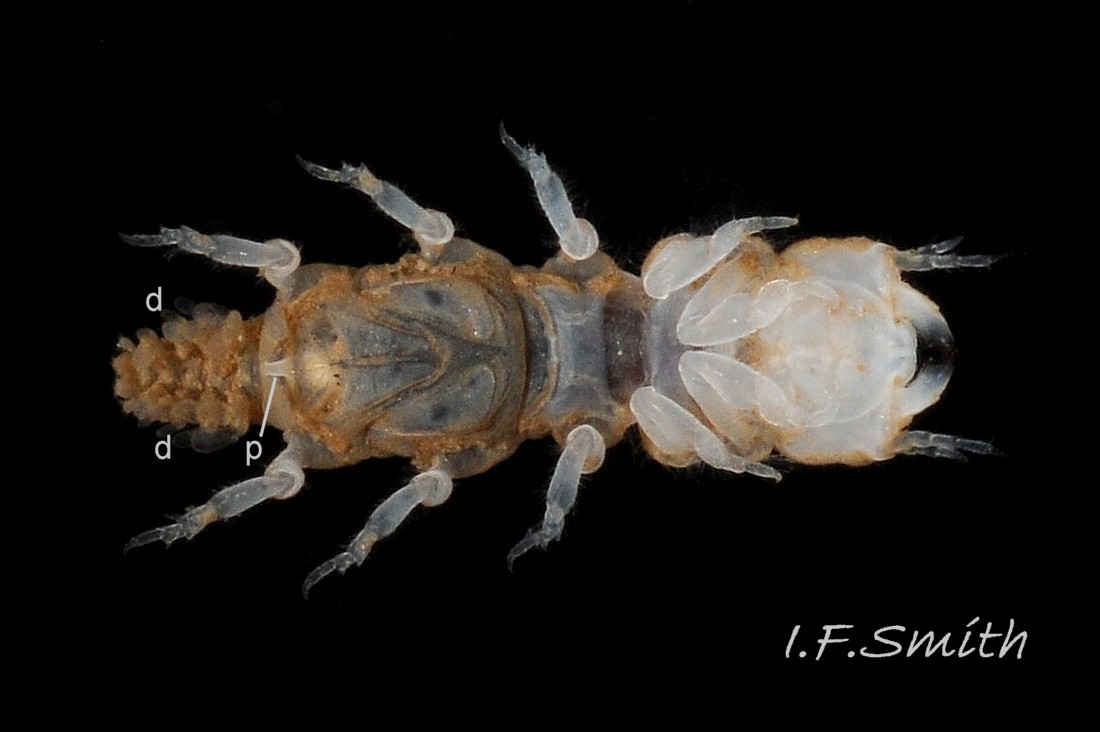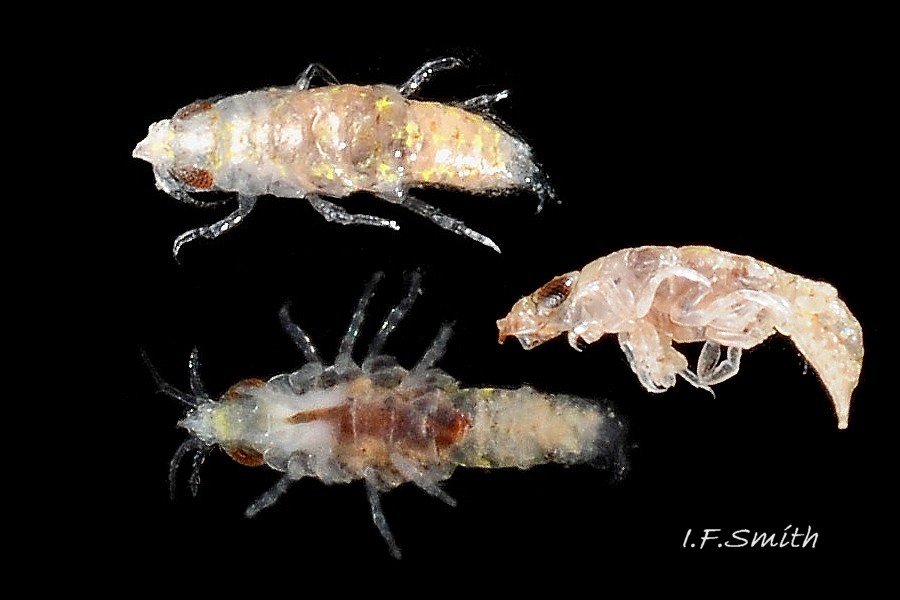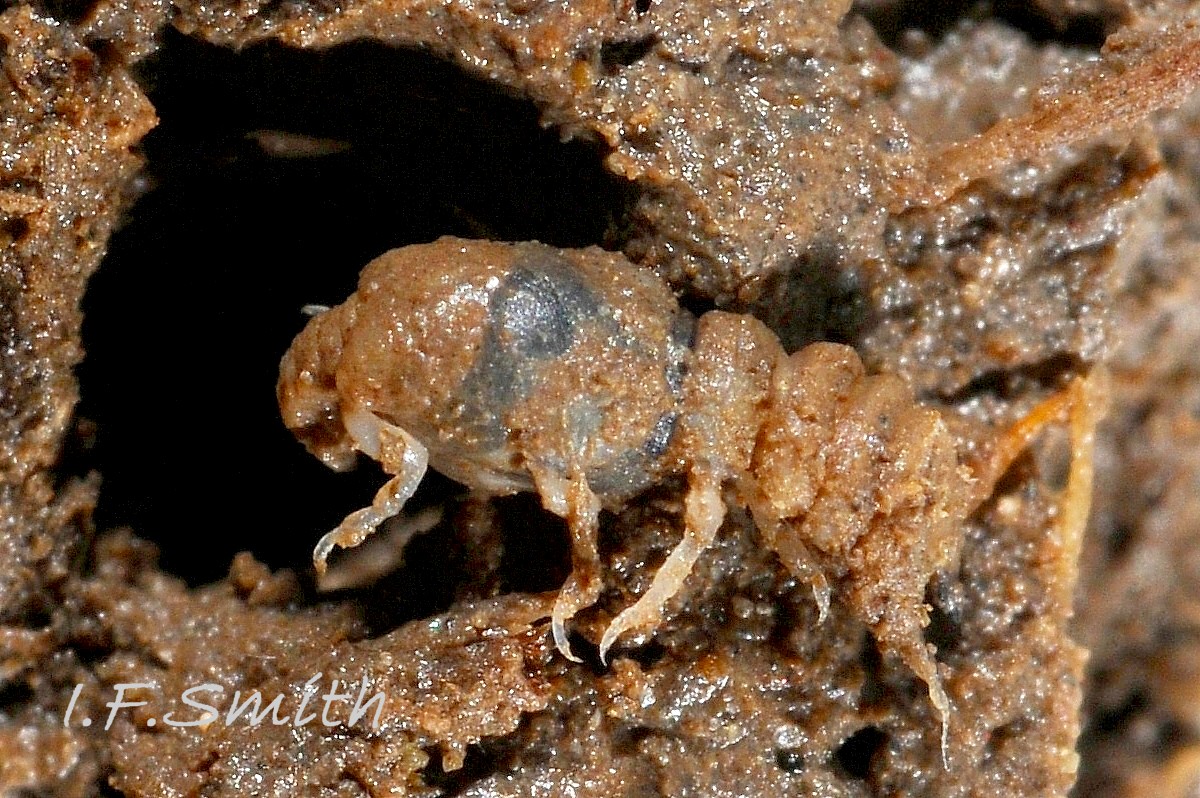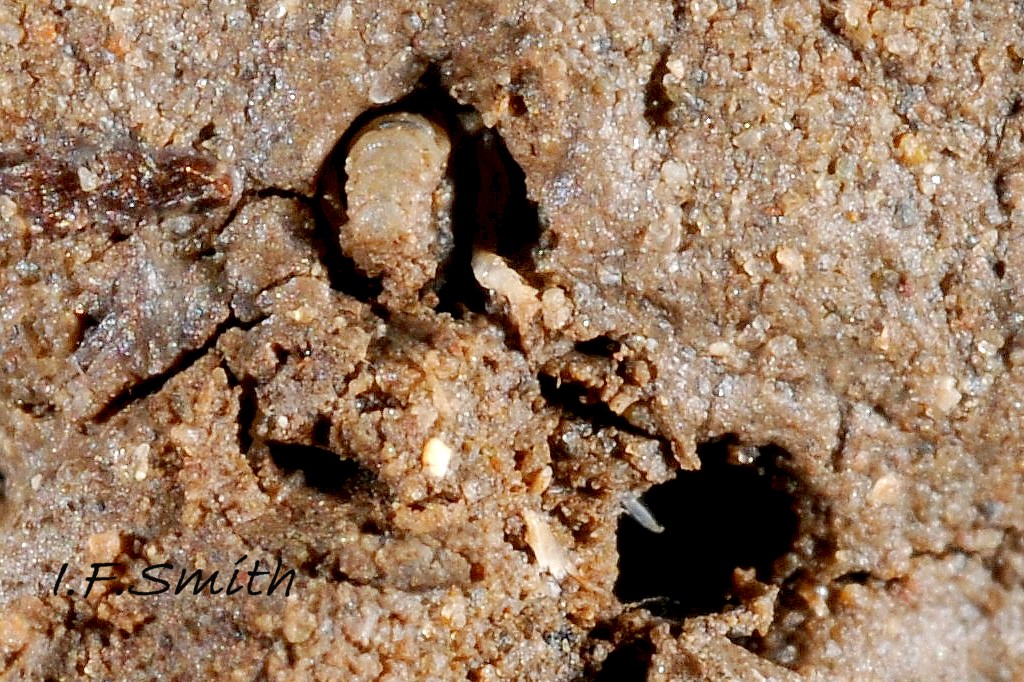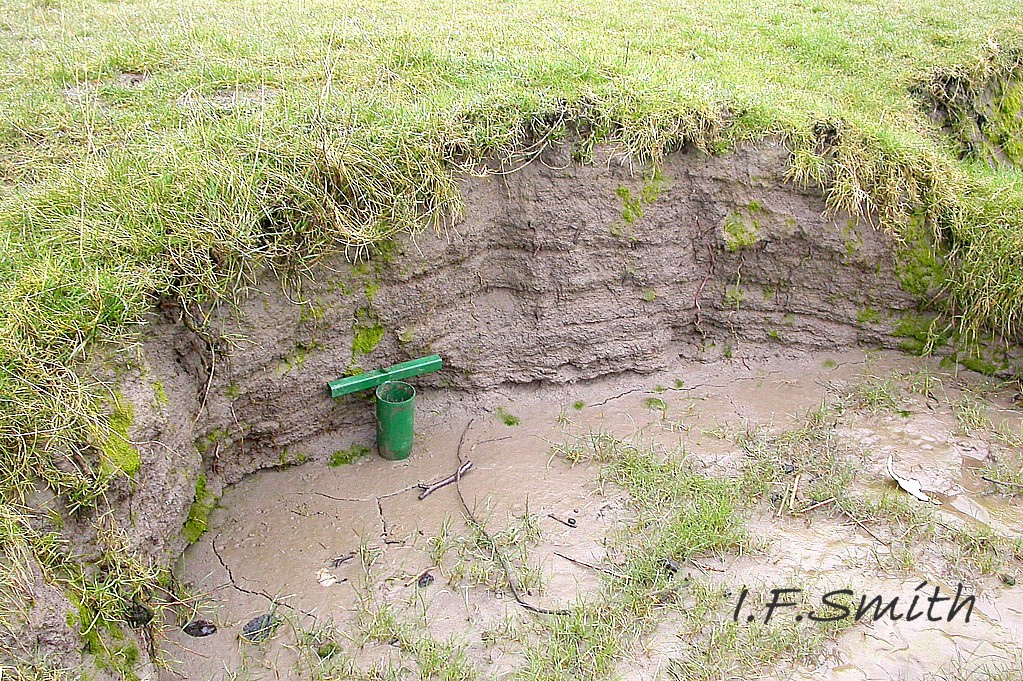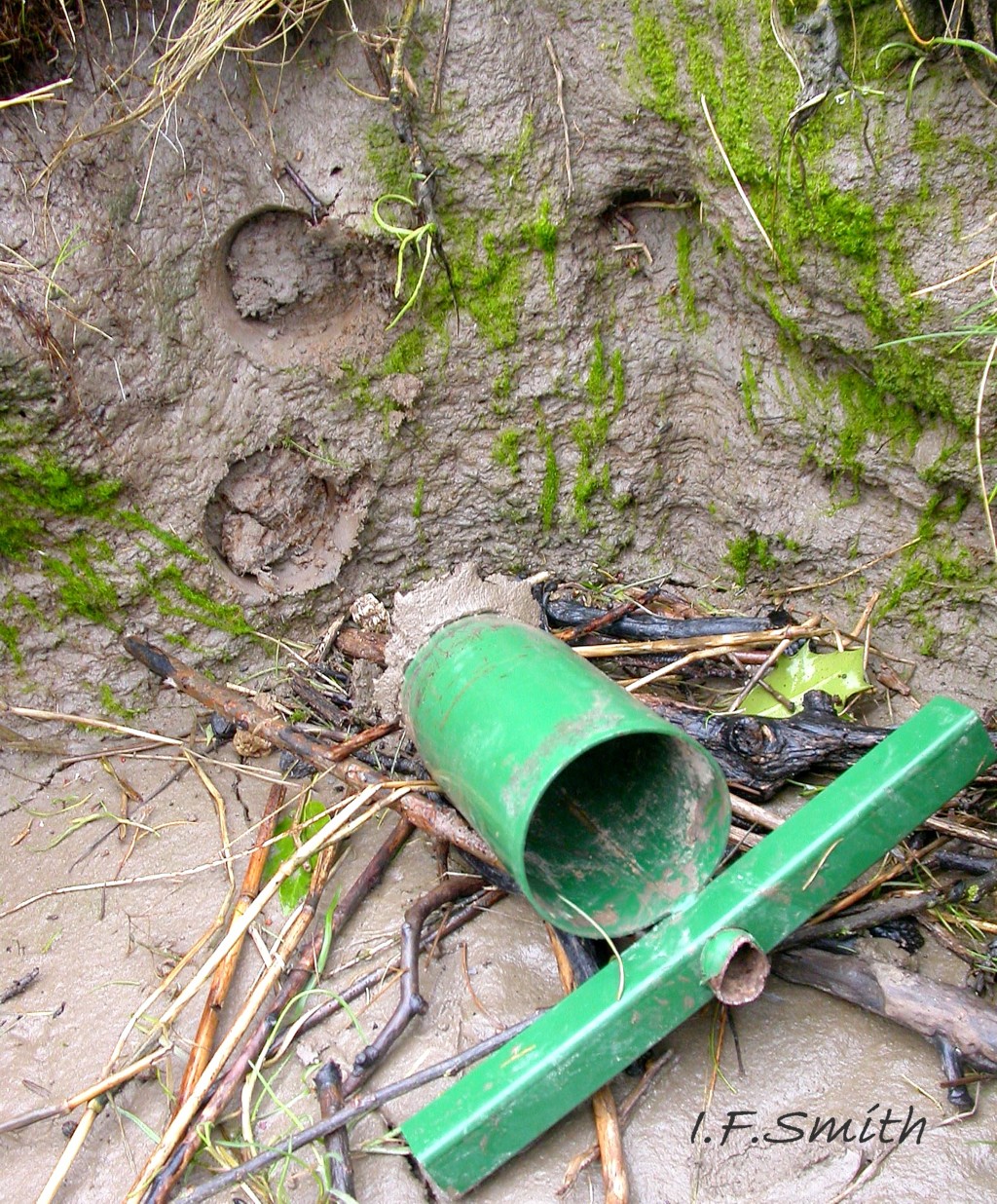Click image to enlarge with full caption. Main text below slider.
Paragnathia formica (Hesse, 1864)
Synonym: Anceus formica Hesse, 1864.
Suggested vernacular name: Salting sultan.
GLOSSARY below.
Abstract
Five pairs of legs for walking (seven on most isopods). Adult males have large heads with protruding mandibles. Adults live near high water mark in burrows in low mud cliffs on saltings from Scotland to Morocco.
In early autumn, larvae released into plankton at high water and parents die. Larvae attach onto small fish to suck blood for two hours to two days. Three larval stages. The three larval blood meals sustain the adults, which never eat, for up to 9 months (females) or 16 months (males). Females live one year and develop quickly, becoming adult by late spring when they are recruited by slower-developing, longer-lived (2 years) males of the previous generation into harems of up to 25. Male stands guard with mandibles inside narrow entrance of burrow, probably helps keep out water. In early autumn at high water of a large spring tide, male widens entrance to admit water which causes gravid females to rupture fatally and release their larvae. Male also dis.
Description
Adult male, adult female and three larval stages have different forms, but all have:
1) Five pairs of ambulatory peraeopods.
2) A cephalon made of the head fused with two peraeon somites 03 Paragnathia formica.
3) Limbs of second fused peraeon somite modified into flattened gnathopods with 5 articles covering mouthparts 05 Paragnathia formica.
4) Narrow “tail” consisting of pleotelson at tip, five pleon somites and, at anterior, a limbless peraeon somite reduced to the same width as pleon somites.
5) Ventrally, pleon has five pairs of biramous respiratory pleopods 04 Paragnathia formica, which may project laterally when in water, and so be visible dorsally 02 Paragnathia formica.
Adult male:
6) Small eyes 02 Paragnathia formica.
7) Large forceps-like mandibles projecting at front of large cephalon.
8) Five large peraeon somites with clearly defined intervening sutures 03 Paragnathia formica
9) Paired penes ventrally at rear of peraeon 04 Paragnathia formica.
Adult female:
10) Small eyes.
11) No mandibles.
12) Cephalon and next two peraeon somites clearly defined by sutures.
13) Next three peraeon somites fused and inflated.
14) Young develop completely in utero; no marsupial brood pouch like that on most female isopods.
Larvae:
Three stages, each subdivided into pre-feeding zuphea and post feeding pranzina. Resemble female except:
15) Eyes large in proportion to head 06 Paragnathia formica.
16) Peraeon swelling varies with feeding.
17) Three posterior peraeon somites not fused until late stage.
Similar species
Items 1-3, above, distinguish P. formica from most other isopods except for:
·British Gnathiidae other than P. formica (Four spp. may occur on shore, more spp. sublittorally)
·Limbs of second fused somite modified into flattened gnathopods with 2-3 articles covering mouthparts.
·Live in rock crevices, Laminaria holdfasts, dead barnacles etc. low down shore on open fully marine coasts, not saltings.
Habitat
Larvae: in plankton, on fish or moulting on/in mud cliff.
Adult males: one or two generations present all year, near 2mm diameter entrance of burrow 08 Paragnathia formica in narrow zone near mean high water mark of neap tide (MHWN) in low mud cliff 09 Paragnathia formica on salting in estuary or by tidal river (varying salinity; down to 0.5 p.p.th). Burrow damp, but water excluded until September .
Adult females: one generation May – September, up to 25 in 5mm diameter harem chamber 07 Paragnathia formica at inner end of 25mm long burrow guarded by male.
Feeding
In each of three stages, larva attaches to fish, especially Gobius microps (Common goby), Platichthys flesus (flounder) and Anguilla anguilla (eel) to feed on blood. Three larval meals entirely sustain adults, which never eat, for up to 9 months (females) or 16 months (males).
Predators
Larvae are major item in diet of same fish that they parasitize.
Life Cycle
(Timings may vary and overlap, and sources differ.)
September
Unfed larvae (zupheas) released into plankton to attach selves to fish and gorge on blood for two hours to two days. Fed larvae (pranzinas) settle on mud cliff in salting and moult over period of 3 weeks to 3 months in small burrows to second stage zuphea. Green (1968) says larvae released April/May near Roscoff, but in N. Wales no females found in burrows March 2013, so larva release not possible there in April.
October – May
Two further stages of parasitism and moulting before third stage pranzinas moult to adults. Development period varies, those that become adults by May are usually female.
May-June
Up to 25 females recruited into harem (with aid of mandibles?) by males of previous generation that have overwintered alone in burrows. From now on, pranzinas moulting to adult are mainly males that dig burrows or use vacant old ones, and wait alone for a year to mate with next generation of females.
June-September
Adult females in harem chamber mate with older male. Young develop entirely in utero. Male near burrow entrance guards against intruders with large mandibles and probably helps block ingress of water.
September
At high water of spring tide, male widens burrow entrance to admit water. Contact with water causes bodies of females to swell, rupture fatally and release next generation of zupheas into plankton. Parents die, but males of same generation as mother still alive alone in their burrows waiting to breed next May.
Distribution and status
Scotland to Morocco. No records from near-tideless Baltic, and only one from weakly tidal Mediterranean, possibly because high water spring tide needed for release of larvae. Most British records on NBN (See data.nbn.org.uk/interactive/map.jsp?srchSp=NBNSYS0000188488 ) from professional surveys on Welsh estuaries. Very few on GBIF (See data.gbif.org/species/2204486/ ) from continental coast of Europe. Probably common but overlooked. At peak release times in September up to one larva per litre of estuary water, and 10% of fish infected. Adults can occur at over 7000/ sq metre in burrows in narrow zone near MHWN.
How to find adults
Seek males any month, females May – early September. Narrow zone of burrows at MHWN can be difficult to locate. Surface indicator species of zone on saltings (N. Sea, Liverpool Bay, Shannon Estuary) is small snail Assiminea grayana (See 02 Assiminea grayana ) but do not confuse with Peringia ulvae (See www.conchsoc.org/spAccount/hydrobia-ulvae ). Zone is easiest to find on tidal river flanked by narrow grassy salting pasture; look for low erosion cliff where pasture ends at river bank. Use bulb digger to take plugs about 3cm deep at intervals down cliff face to maximize chance of striking right level.
Under about X10 magnification, break up plugs; some will have none, but a 6cm diameter sample from the right level may have over 20 males.
References
de Kluijver, M.J. & Ingalsuo, S.S. Macrobenthos of the North Sea wbd.etibioinformatics.nl/bis/crustacea.php?selected=besch…
Green, J. 1968. The biology of estuarine animals. London, Sidgwick & Jackson.
Naylor,E. 1972. British marine isopods. London, Linnean Society & Academic Press.
Tinsley, M.C. & Reilly, S.D. 2002. Reproductive ecology of the saltmarsh-dwelling marine ectoparasite Paragnathia formica. J.Mar.biol. Ass. U.K. 82: 79-84
GLOSSARY
ambulatory – used for walking
biramous – consisting of two main branches
cephalon – isopod head fused with one or two sections of adjacent body.
gnathopod – limbs modified into flattened mouth covering.
gravid – pregnant, carrying eggs or young internally.
in utero – within the uterus/womb.
neap tide – period of about 3 days occurring twice each month when high tides are least high.
peraeon – anterior part of isopod body, equivalent to thorax in insects.
peraeopod – limb attached to the peraeon (“thorax”).
pleon – posterior part of isopod body, equivalent to abdomen in insects.
pleopod – small paddle-like appendage on ventral surface of pleon of isopod used for swimming and or respiration.
pleotelson – posterior segment of isopod’s pleon.
pranzina – swollen fed larva of Paragnathia.
salting – area of salt tolerant vascular plants rooted in sediment between mean high water mark (MHW) and extreme high water of spring tides (EHWS). [preferred synonym for “saltmarsh” as much of salting not marshy]
somite – body segment
spring tide – period of about 3 days occurring twice each month when high tides are highest, usually especially high near spring and autumn equinoxes.
sublittoral – below low water mark, never exposed to atmosphere.
suture – seam-like line of articulation between plates on body.
zuphea – unfed larva of Paragnathia.



